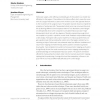Free Online Productivity Tools
i2Speak
i2Symbol
i2OCR
iTex2Img
iWeb2Print
iWeb2Shot
i2Type
iPdf2Split
iPdf2Merge
i2Bopomofo
i2Arabic
i2Style
i2Image
i2PDF
iLatex2Rtf
Sci2ools
PRESENCE
2000
2000
Control Design and Task Performance in Endoscopic Tele-Operation
Endoscopic surgery, while offering considerable gains for the patient, has created new difficulties for the surgeon. One problem is the fulcrum effect, which causes the movement of a surgical instrument, as seen on the monitor, to be in the opposite direction to the movement of the surgeon's hand. The problem has been shown to impede the acquisition of endoscopic skills. Teleoperated robotic arms may circumvent this problem by allowing different control-response relations. Four alternative control designs of a teleoperated device were compared in a simulated endoscopic task. A rigid teleoperated robotic arm with two degrees of freedom representing a surgical tool was coupled to a joystick in a position control mode. Feedback was provided through a video display. Participants without prior experience in endoscopy performed a target acquisition task, first by pointing the robotic arm at the targets, and later by maneuvering an object. Performance was measured under four different c...
| Added | 19 Dec 2010 |
| Updated | 19 Dec 2010 |
| Type | Journal |
| Year | 2000 |
| Where | PRESENCE |
| Authors | Ori Ben-Porat, Moshe Shoham, Joachim Meyer |
Comments (0)

